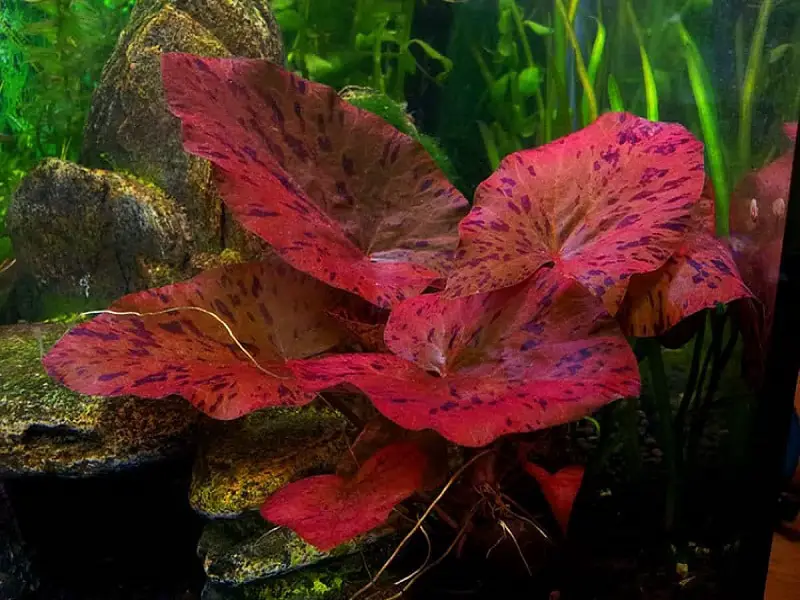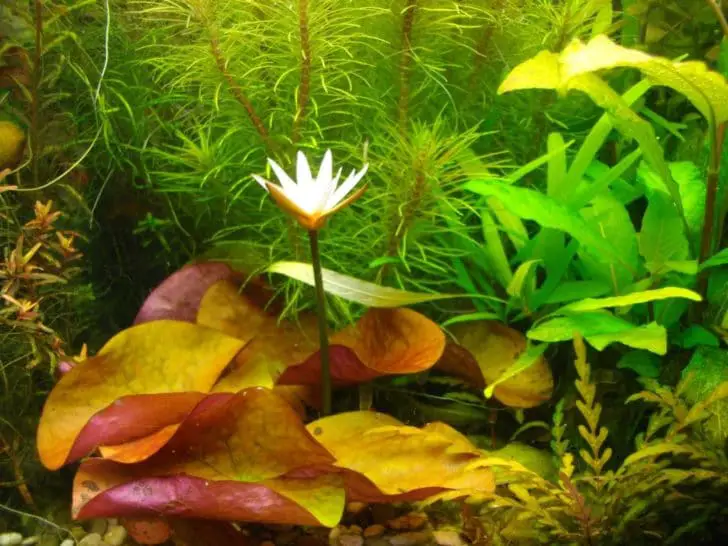Nymphaea Lotus is beautiful aquarium culture that is one of the most expressive and decorative. The fragile flowers of the marsh plant resemble water lilies. This similarity has led to the fact that in everyday life it is called the lotus. But according to the botanical classification, the correct name is “Nymphaea Lotus”.

- Temperature :24-28 ° C
- Rigidity: dGh 2-4 ° C
- Acidity: pH 6-6.8
- Complexity of content: Average
- Plant height 20-80 cm.
- Plant width 25-60 cm.
- Demanding for light: light-loving plant, recommended lighting with a duration of 12 hours
- Reproduction: By cuttings
- Growth rate: Average
- CO2 supply: Mandatory
Table of Contents
Nymphaea Lotus
It is part of the extensive Water Lily family. The nymphaean species has about 70 varieties. But as an aquarium plant, the lotus nymph (tiger water lily) is mainly grown. A number of breeders believe that she is a hybrid specially designed for growing in an aquarium.
Nymphaea Lotus Morphological features:
- The leaves are rounded, heart-shaped, located in a stem rosette, reaching 15 cm in diameter. Before the emergence of leaf plates, the plant throws out multiple underwater ones.
- The root system is powerful, well developed in natural conditions, but less dense at home.
- Colors are formed on a strong peduncle. Outwardly, they resemble an elegant white-pink bowl.
The flowering period is in the second half of July and August. With due observance of the conditions of aquarium maintenance, flowers may appear in early summer.
An interesting ancient Greek reference associated with the name of this plant. When a nymph of unearthly beauty fell in love with Hercules, the ancient hero, unfortunately, did not reciprocate. A beautiful girl died of grief and tears, and after death, she turned into a snow-white flower hovering over the water surface.
Nymphaea Lotus Habitat
Natural habitat almost the entire territory of the earth, with the exception of the cold continent. Nymphaea Lotus prefer to grow in swamps and shaded riverbeds.
Nymphaea Lotus Care and Growing
This aquarium culture is not suitable for beginner breeding. The plant is quite picky and demanding on the conditions of detention. Therefore, it belongs to the average level of difficulty.

General Nymphaea Lotus care recommendations:
- The optimal reservoir for placement is pots or a tropical aquarium.
- In view of the high decorative qualities, the nymphea is planted in the central plan.
- The plant needs regular pruning. Old leaf plates negatively affect its development.
- The recommended height of the water column is up to 50 cm.
- If the change of place inside one water tank goes without consequences, then transferring to a new aquarium can lead to freezing or death of the plant.
- With a decrease in the intensity of illumination, the cuttings stretch more.
In the cold season, the nymphea hibernates and does not throw out the leaves.
OPTIMAL WATER PERFORMANCE
In its natural habitat, the plant develops comfortably in reservoirs with stagnant water. Therefore, old water is preferable. Frequent substitutions are optional. In the present aquatic environment, there is a high concentration of humic acids and organic matter, which has a positive effect on the growth of this culture.
Recommended hydrochemical parameters:
- temperature – 24-28 ° С;
- pH – 6-6.8;
- carbonate hardness – 1-10 ° KH;
- total hardness – 2-4 ° dH.
With a decrease in temperature indicators to 22 ° C and below, the growth of the nymphaea stops. Long-term cooling to 20 ° C is fraught with death. The plant loves a mild, slightly acidic environment. In tough, the Greek water lily begins to grow horizontally, stops producing flower stalks, and thickens the underwater landscape.
LIGHTING REQUIREMENTS
It is necessary to organize a high-quality lighting system, since the plant loves intense lighting. The optimal daylight hours are from 12 hours. If it is not possible to place the nymphaea under direct exposure to sunlight, you should install fluorescent lamps with a power of 0.5-0.6 W per 1 liter.
SOIL QUALITY
Most of the nutrients for this bog plant are obtained from the root system. Therefore, the soil should be with a good concentration of organic matter enriched with useful elements. An excellent option would be a mixture of fine pebbles and clay. The recommended soil thickness is up to 7 cm.
NEED FOR FEEDING
It is necessary to feed the plant in the phase of active growth. It is advisable to periodically add iron salts to the water and apply mineral fertilizers once every 2 weeks at the rate of 1-2 g per 100 liters of water.
Nymphaea Lotus propagation
The most common option is cuttings. To do this, separate the lateral shoots that extend from the rhizome. The length of the shoots should be at least 15 cm. After this manipulation, the shoot is rooted in the ground.
Nymphaea Lotus useful tips
For successful cultivation, here are some proven tips from experienced aquarists:
- As a result of frequent pruning, root rot can begin.
- The nymph should not be planted in the garden soil offered by most flower shops. It is enriched with elements that have a detrimental effect on the hydrochemical parameters of the aquatic environment of the aquarium.
- The plant needs regular planting. This measure will avoid oppression of the mother bush. It is advisable to schedule this procedure for March.
- To stop the rapid growth of the plant, you need to reduce the light intensity.
- If the nymphaea’s leaf plates are damaged during transportation, it is necessary to observe the water lily for 1 month. In most cases, decorative qualities are restored during this period.